
|
Keywords: atmosphere, halo
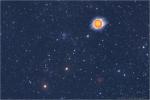 Stars and the Solstice Sun
Stars and the Solstice Sun
21.06.2007
If you could turn off the atmosphere's ability to scatter overwhelming sunlight, today's daytime sky might look something like this ... with the Sun surrounded by the stars of the constellations Taurus and Gemini. Of course, today is the Solstice.
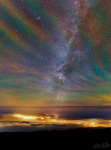 APOD: 2025 June 3 Б Rainbow Airglow over the Azores
APOD: 2025 June 3 Б Rainbow Airglow over the Azores
3.06.2025
Why would the sky glow like a giant repeating rainbow? Airglow. Now, air glows all of the time, but it is usually hard to see. A disturbance however -- like an approaching storm -- may cause noticeable rippling in the Earth's atmosphere.
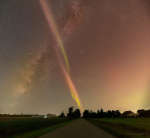 APOD: 2023 September 27 Б STEVE and Milky Way Cross over Rural Road
APOD: 2023 September 27 Б STEVE and Milky Way Cross over Rural Road
27.09.2023
Not every road ends in a STEVE. A week ago, a sky enthusiast's journey began with a goal: to photograph an aurora over Lake Huron. Driving through rural Ontario, Canada, the forecasted sky show started unexpectedly early, causing the photographer to stop before arriving at the scenic Great Lake.
 APOD: 2024 October 28 Б STEVE: A Glowing River over France
APOD: 2024 October 28 Б STEVE: A Glowing River over France
28.10.2024
Sometimes a river of hot gas flows over your head. In this case the river created a Strong Thermal Emission Velocity Enhancement (STEVE) that glowed bright red, white, and pink. Details of how STEVEs...
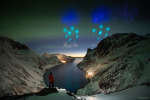 AZURE Vapor Tracers over Norway
AZURE Vapor Tracers over Norway
8.04.2019
What's happening in the sky? The atmosphere over northern Norway appeared quite strange for about 30 minutes last Friday when colorful clouds, dots, and plumes suddenly appeared. The colors were actually created by the NASA-funded Auroral Zone Upwelling Rocket Experiment (AZURE) which dispersed gas tracers to probe winds in Earth's upper atmosphere.
 Cat s Eye Wide and Deep
Cat s Eye Wide and Deep
25.05.2023
The Cat's Eye Nebula (NGC 6543) is one of the best known planetary nebulae in the sky. Its more familiar outlines are seen in the brighter central region of the nebula in this impressive wide-angle view. But this wide and deep image combining data from two telescopes also reveals its extremely faint outer halo.
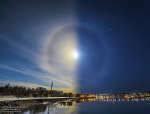 Sun and Moon Halo
Sun and Moon Halo
3.04.2015
Two pictures captured on April 1 are combined in this creative day and night composite. Separated in time by about 10 hours the images otherwise match, looking along the coast at Östersund Sweden.
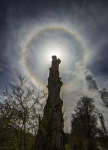 Circling the Sun
Circling the Sun
13.01.2024
Earth's orbit around the Sun is not a circle, it's an ellipse. The point along its elliptical orbit where our fair planet is closest to the Sun is called perihelion. This year...
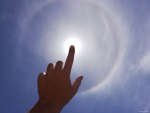 Circular Sun Halo
Circular Sun Halo
14.10.2023
Want to see a ring around the Sun? It's easy to do in daytime skies around the world. Created by randomly oriented ice crystals in thin high cirrus clouds, circular 22 degree halos are visible much more often than rainbows.
 APOD: 2023 December 20 Б Ice Halos over Bavaria
APOD: 2023 December 20 Б Ice Halos over Bavaria
20.12.2023
What's causing those unusual sky arcs? Ice crystals. While crossing a field of fresh snow near Fцssen, Bavaria, Germany, earlier this month, the photographer noticed that he had entered an ice fog.
|
January February March April May June July |
|||||||||||||||||||||||||||||||||||||||||||||||||